Tag: weston davis
Jo Ann Hopkins and her 12-year-old Appendix-bred gelding, Blazer, were placed third in points in their local 1D barrel racing circuit. However, three months earlier, Blazer underwent surgery at Palm Beach Equine Clinic for a growing cyst in his sinus. On August 1, 2015, Dr. Weston Davis, DACVS, performed the surgical procedure on Blazer for an expansile paranasal sinus cyst of the left paranasal sinuses, extending to the right concho-frontal sinus.
Hopkins noticed that Blazer, who she calls “George” for his laid-back attitude, had a raised knot on his head this spring and consulted with her local vet, Dr. Kelly Alderman. The area was monitored closely and remained in a similar condition until June, when Hopkins noticed Blazer wheezing while running barrels and the knot increasing in size.
Diagnosing the Paranasal Sinus Cyst
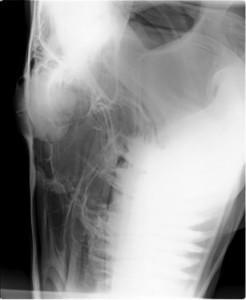
Dr. Alderman performed radiographs on the site and aspirated the swelling where a substantial amount of fluid was removed. She confirmed that the bump was a suspected paranasal sinus cyst. At that point, Blazer was referred to Dr. Weston Davis of Palm Beach Equine Clinic, who advised Hopkins that the cyst was likely growing slowly within the sinus for a considerable amount of time with no clinical signs. The diagnosis was an expansile paranasal sinus cyst of the left paranasal sinuses, extending to the right frontal sinus.
Paranasal Sinus Cyst Surgery
For surgery, Blazer was placed under standing sedation and local analgesia (painkiller) and his head was aseptically prepared before Dr. Davis performed a frontonasal sinusotomy (incision into the sinus). He made an opening from the middle of Blazer’s head to the corner of his eye. Once the skin flap was elevated and the bone fractured, a large amount of fluid was evacuated, which is consistent with the contents of a paranasal sinus cyst. Dr. Davis also observed that the sinus cavity was extremely distorted and expanded. The cyst lining was debrided and removed, then the sinus was lavaged and a tube was advanced into the sinus cavity to facilitate drainage. The sinus was packed with gauze tied together and soaked in a dilute betadine. Finally, the bone flap was replaced and the skin was closed and covered with a sterile bandage.
Recovery
The gauze packing was removed 48 hours after surgery and upon release from Palm Beach Equine Clinic, Hopkins was instructed to monitor the incision for heat, swelling and discharge. Bute, in the amount of 2g, was administered orally once a day for five days and Dr. Alderman removed the sutures after 10 days.
Hopkins characterizes Blazer as a sweet gelding with heart to spare, and is happy to report that his recovery has been fantastic. After six weeks of stall rest and rehab time to get back in shape, Blazer recently won his first barrel race after surgery. According to Hopkins, Blazer is running better than ever thanks to Dr. Davis and the staff at Palm Beach Equine Clinic.
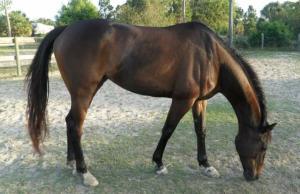
Palm Beach Equine Clinic is renowned for its exceptional care of performance sport horses of all disciplines around the world. Sometimes, the veterinarians and surgeons have the opportunity to treat the horses owned by their colleagues. This summer, Palm Beach Equine Clinic veterinary technician Megan O’Neal experienced the clinic’s surgical expertise firsthand when her rescued off the track Thoroughbred (OTTB) was diagnosed with severe spinal impingement (kissing spines).
Signs and Symptoms
O’Neal adopted Blessing, a 10-year-old mare, almost three years ago. After Blessing’s career on the track ended, she was given to Pure Thoughts Horse Rescue in Wellington, FL. Blessing had moved through a few foster homes before O’Neal gave her a forever home. Blessing had been successfully jumping three-foot courses with one of her previous foster homes. After adopting Blessing, O’Neal was jumping the mare as well, but only about two-feet high. She had plans to compete, but Blessing’s behavior changed under saddle. The mare began rearing and bolting, endangering both herself and her rider. Her attitude on ground handling turned sour as well, no longer enjoying being groomed and pinning her ears in agitation.
Identifying the Problem

With the help of Palm Beach Equine Clinic surgeon Dr. Weston Davis and the advanced imaging technology available at PBEC, O’Neal was able to pinpoint the cause of Blessing’s troubling change in behavior. The diagnosis was severe chronic back pain with dorsal spinous process impingement (kissing spine lesions). The vertebrae in her back from T16 – L1 were affected, which is the mid-section of the horse’s back, in the general region of where the back of the saddle sits.
Addressing the Problem Through Non-Surgical Treatments
The first course of action was to try several non-surgical techniques to treat Blessing’s pain. Dr. Davis tried treatments of intramuscular injections for arthritic pain and corticosteroid injections in between the spinal vertebras. A veterinary chiropractor adjusted the mare every few weeks. For almost eight months, several additional methods were tried to avoid kissing spines surgery including acupuncture, back stretches and oral muscle relaxants. In July, when the pain continued after all their efforts, O’Neal finally decided that surgery was the only option for recovery.
Kissing Spines Surgery
In the state-of-the-art hospital at Palm Beach Equine Clinic, Blessing was sedated to obtain pre-operative radiographs that map the exact site of the lesions. She was placed under general anesthesia and the surgical site was sterilely prepared. Dr. Davis made a single 20cm incision on the dorsal midline over the palpable dorsal spinous processes. Eighteen-gauge needles were inserted at regular intervals and used as radiographic markers to identify the interspinous spaces. The incision was extended through the supraspinous ligament at each site.
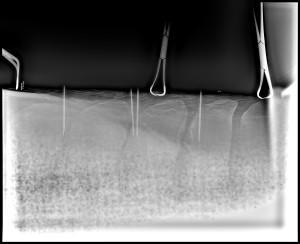
Dr. Davis used sterile surgical equipment, known as a bone rongeur, to elevate the soft tissues and resect some of the affected dorsal spinous processes (DSPs). The rongeurs, which are similar to large pliers, were used to slowly remove the edges of the overriding bone. This process frees the space between adjacent vertebrae until widened enough that the index finger of the surgeon could easily pass in the interspinous space. The site of resection was lavaged to remove any loosed tissues. Lastly, Intra-operative radiography was used as needed to confirm the location and completion of the surgery. Following confirmation, the supraspinous ligament was internally closed with absorbable sutures. The skin was closed with surgical staples and a stent was sutured in place over the incision. After several weeks of healing, the stent and staples were removed.
The kissing spines surgery was performed without complication and Blessing was provided a good prognosis. Soon after surgery, the space that was created between vertebrae filled with a non-painful, fibrous scar tissue. Blessing went home the following day after surgery. She was monitored closely at home and received routine peri-operative antibiotics (gentamicin and penicillin) and anti-inflammatories (phenylbutazone) for pain. Recently, O’Neal was given the okay from Dr. Davis to resume riding for normal exercise. O’Neal looks forward to continuing her partnership with this special mare. Thanks to Dr. Weston Davis and the team at Palm Beach Equine Clinic for their exceptional care to get Blessing back to happy and healthy!
A 12-year-old show jumper is moving nicely just 2 months after laboring to walk.
Palm Beach Equine Clinic Staff Surgeon Dr. Weston Davis operated on a severe lameness case on July 5 that had quickly progressed into an emergency situation.
Evaluation and Diagnosis
Annabelle was referred to Palm Beach Equine Clinic for advanced imaging and evaluation of severe subsolar abscessation in the Holsteiner mare’s left front foot that was not responding to aggressive therapies.
She was diagnosed with infectious pedal osteitis in the left fore and early stages of support limb laminitis in the right fore. Pedal osteitis is an infection of the coffin bone. Annabelle previously showed in the Adult Jumpers with her owner, Jennifer Knobel, but the infection had advanced to the point that she could barely walk.
Local veterinarian Dr. Kim Snyder vigorously managed Anabelle’s foot condition in the field before referring the case to Palm Beach Equine Clinic. She performed digital radiographs at the farm, but they failed to adequately define the lesion. She requested an MRI study of the foot to more accurately image the underlying causes of the persistent foot abscess, such as a foreign body, bone infection, sequestrum, or tumor.
Advanced Medical Imaging Technology
 As the radiographs were not definitive enough alone, the team at Palm Beach Equine Clinic used their state-of-the-art MRI technology for a more detailed analysis. The MRI showed excess fluid and severe inflammation within the coffin bone. The infectious pedal osteitis had caused the bottom of the coffin bone to begin to deteriorate. Worsening the situation, Annabelle was reluctant to bear weight on her left foot. Then she developed mild laminitis in her right foot due to the increased load on the supporting limb to relieve pressure. The development of support limb laminitis determined the emergency status of the left fore lameness as laminitis could be a fatal complication.
As the radiographs were not definitive enough alone, the team at Palm Beach Equine Clinic used their state-of-the-art MRI technology for a more detailed analysis. The MRI showed excess fluid and severe inflammation within the coffin bone. The infectious pedal osteitis had caused the bottom of the coffin bone to begin to deteriorate. Worsening the situation, Annabelle was reluctant to bear weight on her left foot. Then she developed mild laminitis in her right foot due to the increased load on the supporting limb to relieve pressure. The development of support limb laminitis determined the emergency status of the left fore lameness as laminitis could be a fatal complication.
Dr. Davis and the team at Palm Beach Equine Clinic took immediate action using the MRI scans for accurate surgical mapping. The MRI study documented exactly where the infectious pedal osteitis was located. This mapped position was used in comparison to the previously taken radiographs. Both imaging modalities were used intra-operatively to guide Dr. Davis precisely to the area of infected bone.
Surgery and Recovery
Annabelle was placed under general anesthesia, and the left front limb was prepared for surgery. A 5 cm long x 3 cm wide window was cut through the sole down to the surface of the coffin bone, through which the necrotic (infected) bony tissue was removed. Prior to recovery, the surgical site was packed with antibiotic powder and a full distal limb bandage was applied. Additional support of Soft-Ride boots and sole supports were positioned. Medical grade maggots were applied to the foot the day after surgery to safeguard absolute full debridement of all necrotic/infected tissues.
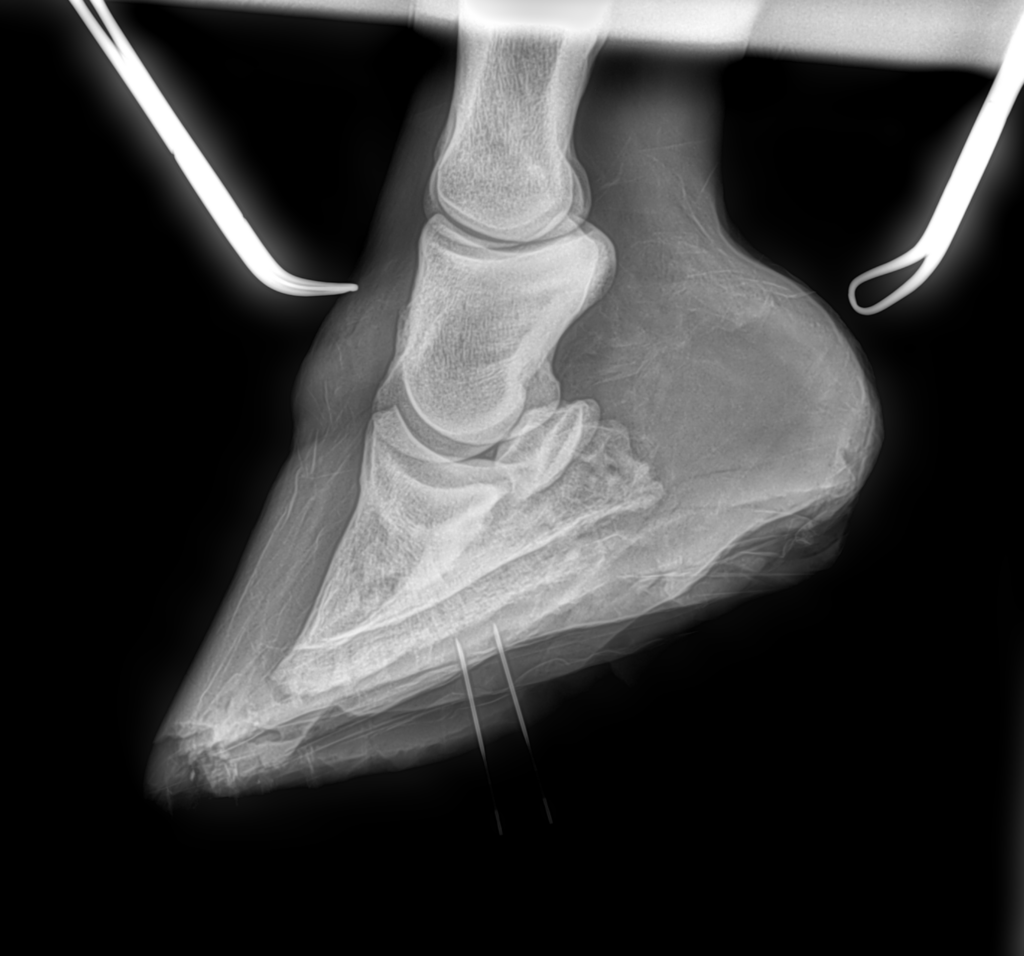
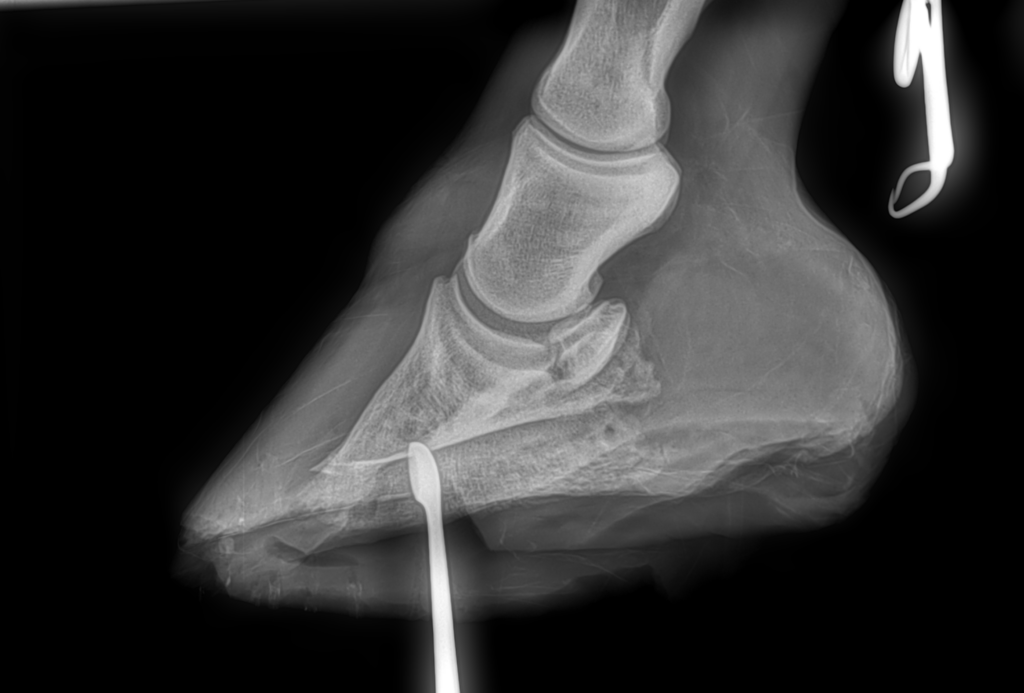
 Annabelle was placed on a range of antibiotics. Pain was managed with local nerve blocks and anti-inflammatory medications. Her pain improved rapidly in the operated left limb and signs of laminitis in the right fore resolved as well. During her stall rest recovery, the foot was soaked routinely in Epsom salts. Betadine soaked gauze was applied over the frog and surgery site each day and the hoof was wrapped for protection.
Annabelle was placed on a range of antibiotics. Pain was managed with local nerve blocks and anti-inflammatory medications. Her pain improved rapidly in the operated left limb and signs of laminitis in the right fore resolved as well. During her stall rest recovery, the foot was soaked routinely in Epsom salts. Betadine soaked gauze was applied over the frog and surgery site each day and the hoof was wrapped for protection.
Snyder continued to care for Annabelle in the post-op period. Synder’s husband and farrier, Jim Gilchrist, applied a shoe with a treatment plate to protect the bottom of the foot. This allowed for routine access by removal of three simple screws.
The initial cause of the abscess or why the infectious pedal osteitis progressed so aggressively is still unclear. Dr. Davis speculates that it was possibly a spontaneous abscess and for whatever reason, whether the depth into the foot or the presence of a highly infectious bacteria, Annabelle was just unlucky. Instead of draining like a “normal” abscess, this particular case established an infection within the bone. This made it impossible to clear the infection with even the most aggressive medical therapies apart from surgical removal.
 Annabelle’s infectious pedal osteitis has cleared and her hoof is healing well. Now she is walking sound and has a favorable prognosis for further improvement with hopes of eventually return to work.
Annabelle’s infectious pedal osteitis has cleared and her hoof is healing well. Now she is walking sound and has a favorable prognosis for further improvement with hopes of eventually return to work.
Thoroughbred Brazilian Triple Crown winner Bal a Bali was admitted to Palm Beach Equine Clinic on August 3, 2014. The elite athlete was treated for life-threatening laminitis by board-certified surgeon Dr. Weston Davis of Palm Beach Equine Clinic, in conjunction with Dr. Vernon Dryden, just months after his Triple Crown win in March of that year.
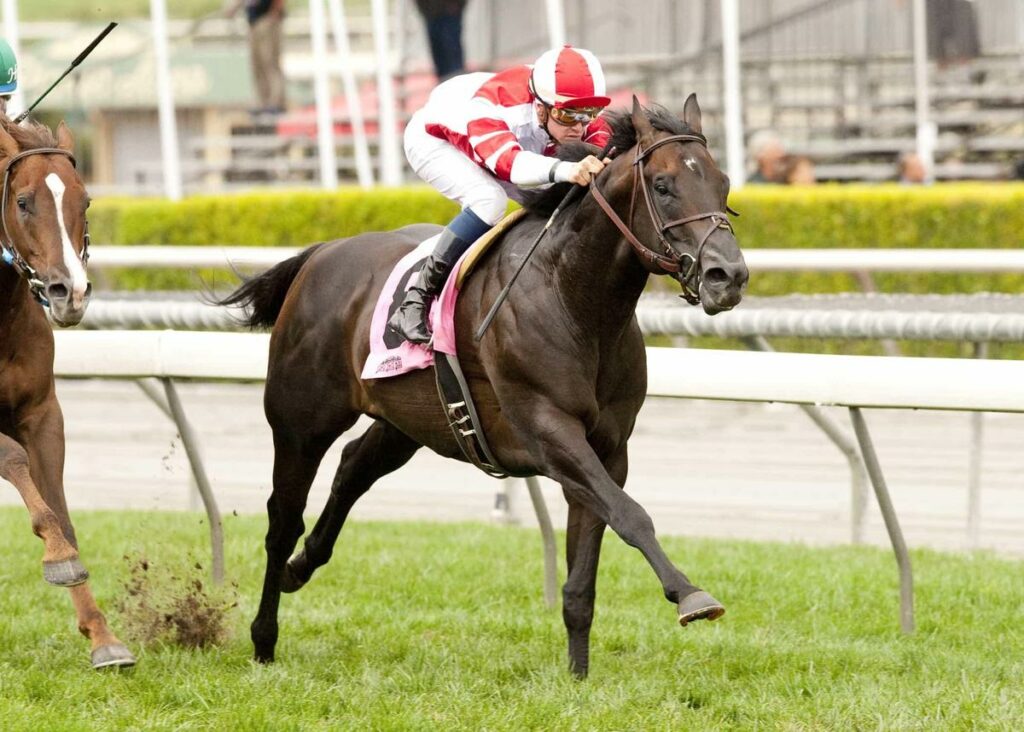
Brazil’s 2014 Horse of the Year, Bal a Bali (Put It Back—In My Side, by Clackson) took an impressive win in the Grande Premio Cruzeiro do Sul (Brz-I) to become the country’s 12th Triple Crown winner. He finished the race in track-record time at Gavea racecourse.
Following his last start in June 2014, Bal a Bali was purchased by Fox Hill Farm and Siena Farm and imported to the U.S. in late summer, but unfortunately suffered from laminitis brought on during his travels. Bal a Bali was in a Florida quarantine center scheduled to fly to trainer Richard Mandella’s stable in California when the problems developed.
Bal a Bali Admitted to PBEC Equine Hospital
Bal a Bali was quickly moved to Palm Beach Equine Clinic in Wellington, Florida, where he was received by Dr. Weston Davis, who would oversee his care in the equine hospital for the next three months. Palm Beach Equine Clinic set aside an entire section of the hospital barn as a quarantine unit to meet the horse’s final import requirements while he was treated with aggressive cryotherapy – a gold standard of laminitis care. Hospital staff carefully monitored Bal a Bali and treated him with consistent cold-water spa treatments for several days throughout the severe acute phase of this disease. He was gradually weaned out of the spa as he improved clinically.
On two occasions, Dr. Davis performed intravenous regional perfusions of the horse’s feet with advanced stem cell treatments. A myriad of other medical therapies were administered throughout his stay. The progression of his laminitis was closely monitored with the use of diagnostic imaging and meticulous farrier care. Farriery care included ensuring optimal sole support and proper mechanics to decrease strain on the fragile lamina. By October, the horse was cleared to travel to Siena Farm in Kentucky. There, Dr. Dryden continued to treat the horse and he was then flown to California in January.
Winning his Battle with Laminitis
After a nine-month recovery process, Bal a Bali made a miraculous return to the track for his North American debut in May 2015. He cruised to victory in the $100,000 American (G3), a one-mile turf race for three-year-olds and up at Santa Anita Park. At that point, the five-year-old had captured 12 of 13 career starts and earned $570,078.
Bal a Bali’s comeback was no doubt a result of the outstanding care he received at Palm Beach Equine Clinic under the extraordinary supervision of Dr. Weston Davis and Dr. Vernon Dryden.
Thank you Fox Hill Farm and Siena Farm for the trust you placed in Palm Beach Equine Clinic.
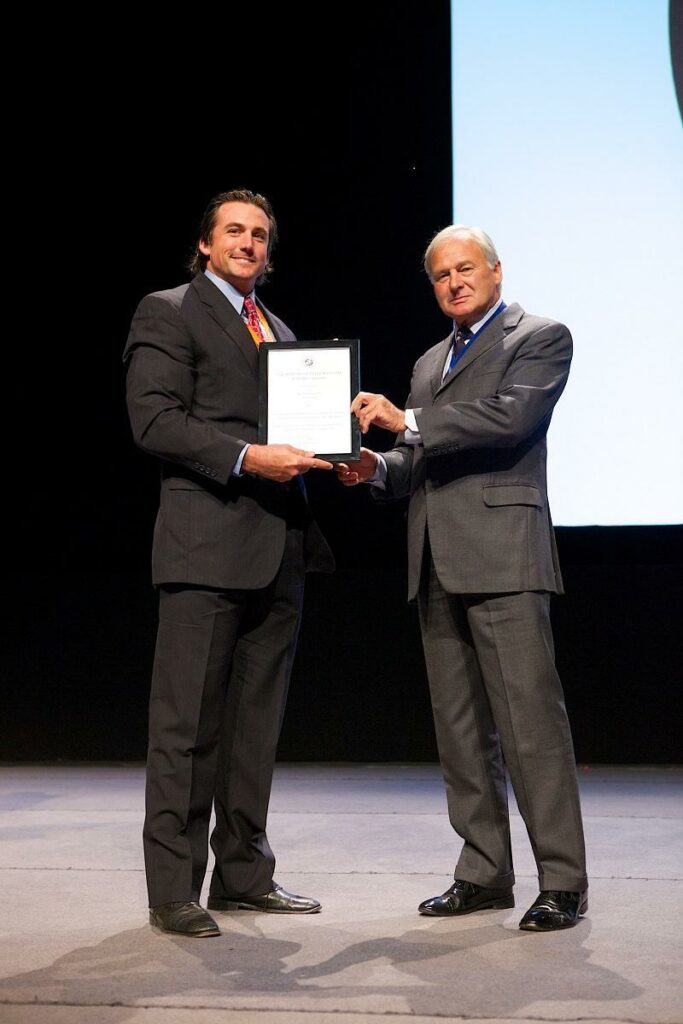
Congratulations to Dr. Weston Davis for winning the BEVA Trust Peter Rossdale EVJ Open Award at the 2014 BEVA Congress in Birmingham. The award was for a paper Dr. Davis wrote entitled:
Palm Beach Equine Clinic welcomes new veterinarian Radiologist, Dr. Sarah Puchalski, and Surgeon, Dr. Weston Davis. Dr. Puchalski is a Diplomate of the American College of Veterinary Radiology. Her specialty includes the interpretation of radiographs in addition to other diagnostic imaging techniques.
New Team Members
With Dr. Puchalski’s addition, Palm Beach Equine Clinic is pleased to be one of few practices in the country with a full-time board certified radiologist.
Dr. Davis is a Board Certified surgeon specializing in equine sports medicine. Dr. Davis joins Dr. Bob Brusie and Dr. Jorge Gomez at Palm Beach Equine Clinic providing exceptional surgical expertise in orthopedic and soft tissue related problems including emergency colic surgery.
Expanded Facilities
In addition to this exciting news comes the announcement of a new expansion to their veterinary hospital. PBEC is located less than one mile from the Winter Equestrian Festival and across the street from the Global Dressage Festival. The expansion includes a new barn containing 11 intensive care stalls capable of providing advanced medical treatment and post-operative care. The added stalls and office space makes Palm Beach Equine Clinic the most progressive, well-equipped facility in the region for equine veterinary care.
Palm Beach Equine Clinic (PBEC) is the one of the select few equine hospitals in the country with three board-certified surgeons. With 24 veterinarians on staff, they are the most complete hospital in the southeast United States, ready to handle any emergency as well as elective surgery and preventative care.
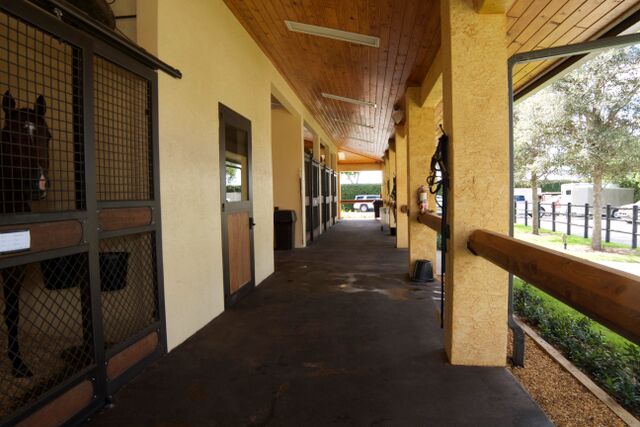
Exceptional Equine Medical Care
Palm Beach Equine Clinic has locations in Wellington, Florida, Long Island, New York and satellite veterinarians throughout the United States. PBEC provides exceptional equine medical care with an unwavering commitment to the horse for more than 30 years. Working with patients that range from the reliable amateur horse to Olympic athletes, PBEC’s mission from day one has been to provide innovative veterinary services that promote health and happiness in horses while extending their performance careers. With this mission in mind, Palm Beach Equine Clinic remains the leading service provider in equine veterinary medicine.
From December 1st, 2013 through April 1st, 2014, PBEC is pleased to offer tours by appointment. After scheduling an appointment, guests can look forward to a tour of the facility and time to talk with veterinarians. Tours will include the new hospital, Nuclear Scintigraphy room, and Surgery Center. Visitors will have an opportunity to ask questions and meet all the new doctors on staff. PBEC is located at 13125 Southfields Road in Wellington, Florida.
Contact PBEC for more information
Palm Beach Equine Clinic is respected throughout the industry. Well known for an unwavering commitment to the horse and their owners, PBEC offers innovative, advanced medical care. Known as leaders in new diagnostics and therapies, PBEC veterinarians have published numerous articles in equine magazines and journals.